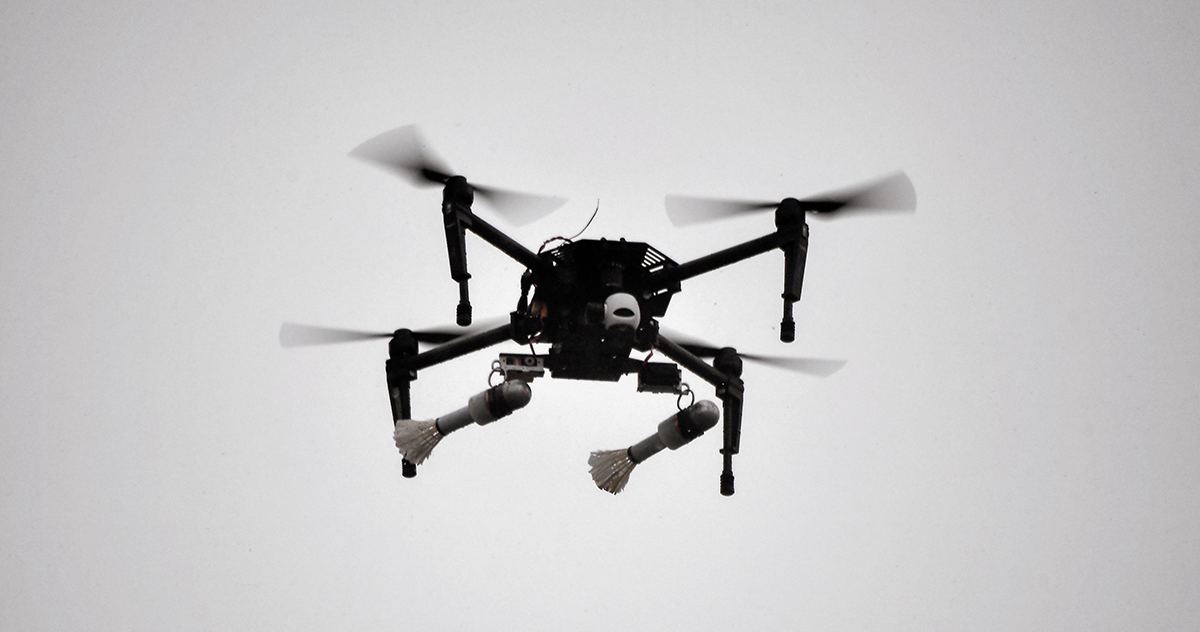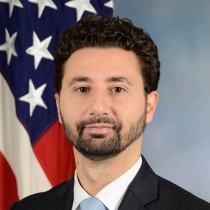

Introduction
As unmanned aerial vehicle (UAV) technology becomes ever cheaper and more accessible, the threat of armed and GPS-guided drones is becoming a serious problem for U.S. forces in theater. In the past few months, Iranian-backed Iraqi militias have used small drones armed with explosives to attack Iraqi military bases housing U.S. forces several times, and the threat posed by such UAVs is only likely to grow in the months and years to come. Experts from MEI's Defense & Security Program weigh in with their thoughts on how the U.S. should respond to this emerging threat, as part of the new Defense Rapid Reaction series.
Reactions
-
Joseph L. Votel
Joseph L. Votel

Unmanned systems are both a blessing and curse
As a former U.S. Special Operations Command and Central Command commander, unmanned technologies were vital to our mission success. They allowed us to conduct long-term persistent surveillance, they significantly aided in reduction of civilian casualties and collateral damage, they allowed us to operate with an economy of force, and they reduced force protection concerns for troops on the ground and pilots in the air. It is another example of how technology has helped us make a significant leap in operating capabilities. I can think of almost no operations conducted during the campaign against ISIS that did not use these capabilities to our advantage.
But as advantageous as this has been for our forces, it is also a growing advantage for our adversaries. The proliferation of small UAVs, locally modified by ISIS terrorists, presented a unique and dangerous threat to our troops on the ground in both Iraq and Syria. Highlighting this threat and the need to ensure that we had adequate protection measures was a frequent feature of my routine updates to our leadership. It is a difficult challenge to address: What a terrorist can do for a few hundred dollars often requires an investment of thousands on our part to defeat — the absolute definition of an asymmetry.
It is time for us to take this threat seriously. It not only poses risks to our forces in far-off overseas locations, but it is in fact a threat to many of our civilian and commercial activities right here in the homeland. If we don’t think that our adversaries, or those bent creating chaos or undermining our interests, will take advantage of this, we only need to look back a few weeks to what hackers did with the Colonial Pipeline. Unmanned systems are both a blessing and curse — and it is time to look at them in that way.
Gen. (ret.) Joseph L. Votel is a distinguished senior fellow on national security at the Middle East Institute. He retired as a four-star general in the U.S. Army after a nearly 40-year career, during which he held a variety of commands in positions of leadership, including most recently as commander of CENTCOM from March 2016 to March 2019.
-
Bilal Y. Saab
Bilal Y. Saab

Solutions will come, but they may not be cost-effective
The growing threat posed by unmanned aerial systems (UAS), coupled with our lack of dependable capabilities to counter them, is the most worrying tactical development in the CENTCOM area of responsibility since the rise of the improvised explosive device (IED). That’s what CENTCOM Commander Gen. Frank McKenzie said recently, and I certainly share his assessment.
We have addressed the issue of IEDs by building highly survivable mine-resistant ambush protected vehicles that are capable of lessening the impact of low-cost enemy tactics, including mines, explosive devices, and rocket-propelled grenades.
While we haven’t conquered the IED problem, we’ve certainly made serious inroads thanks in large part to U.S. technology and political leadership. With the UAS challenge, however, it seems we’re not even close. Things are so bad that sometimes we can’t even see an attack coming, despite our overhead signals intelligence.
Much more than with IEDs, adversaries have plenty of room to get creative with UAS. They can change their tactics, techniques, and procedures, mask the signals of their flying objects, and conduct multiple launches simultaneously along the same flight path and then later split them off toward different target areas (some of that we witnessed in the Saudi war in Yemen). All of this considerably complicates our threat warnings and ability to respond effectively.
I’m confident that U.S. innovation once again will come up with better responses to the UAS problem. But what I’m less sure of is if those solutions will be cost-effective. If the enemy forces us to massively outspend, we’ve already lost.
Bilal Y. Saab is a senior fellow and director of the Defense and Security Program at the Middle East Institute.
-
Eric Oehlerich
Eric Oehlerich

We need to re-tool to rapidly respond to new threats
Air superiority is required to operate safely within any area of conflict. What used to be done with long-term programs and the deployment of aircraft has now been replaced with off-the-shelf, relatively cheap aerial systems in the form of drones.
Drone technology is available to anyone, anywhere around the world. An engineering degree isn’t required to modify the cargo a drone delivers — or, sadly, to turn one into a flying improvised explosive device (IED).
Although not widely publicized, drone IED attacks have been carried out recently against U.S. forces or our allies within the Middle East and Africa. Manning the walls of a forward operating base with a shotgun has been an unacceptable answer in recent operations. While the U.S. bureaucratic procurement system stifles timely research and development for a counter-drone capability, the open market continues to evolve. According to a June New York Times article, in a battle in Libya last year soldiers were most likely engaged repeatedly by an autonomous lethal drone powered by artificial intelligence (AI).
Let that settle in for a minute: an untethered, unmanned, lethal drone with AI-driven target selection.
Our global market produces unprecedented technology, and that leaves us with a simple equation: Either our Defense Department operates at the speed of the open market or we increase the risk to our operations and people. The U.S. must re-tool the way we put capabilities in the hands of our personnel, or we will be at a tactical disadvantage to our most basic enemies.
Eric Oehlerich is a retired U.S. Navy Commander (SEAL) from the Naval Special Warfare component of the USSOCOM’s Joint Special Operations Command. He is a Non-Resident Senior Fellow for Technology and National Security with MEI, an Analyst for ABC News, Co-founder of End Child Soldiering and the Lobo Institute, and serves on the board of directors for the Grassroots Reconciliation Group.
-
Michael K. Nagata
Michael K. Nagata

The technology is advancing rapidly and the US is failing to keep up
The staggering pace of technological improvements in UAVs (aka “drones”) was recently described by the CENTCOM commander as “… the most concerning tactical development since the rise of the improvised explosive device [IED] in Iraq.” To place this assertion in context, thousands of American servicemembers have been wounded, maimed, or killed by IEDs. Also, it took several years for the U.S. government to provide a reasonably adequate set of response and defensive capabilities.
Unfortunately, the rapid technological advances in drone capabilities, and thus their growing military applications, are breath-taking. Improvements in range, cargo-capacity, speed and agility, and perhaps most concerning of all, increasing “autonomy” that frees them from the limitations of a human operator, mean that the military significance of unmanned aerial systems will keep expanding rapidly. We can be certain about this because drones are enjoying the same expansion and adoption that we’ve come to expect from other technologies, like mobile phones, driverless cars, cloud-based computing, and more. Barriers to entry are collapsing everywhere, allowing any state or non-state actor to procure increasingly powerful drones.
This raises the question of whether the U.S. government is today on a trajectory to match this pace of drone technology development, and if it is learning how to master this technology for both defensive and offensive purposes in ways that are superior to what potential adversaries and competitors are doing. Sadly, the answer at present is no. Today, the United States government is neither keeping pace with the technology, nor matching how swiftly its adversaries or competitors globally are embracing it.
Ironically, the U.S. expertise and ability to do both already exists, but they reside almost entirely in the commercial/industrial sectors, and the processes by which the government must identify, fund, and acquire these strengths are too cumbersome, risk-averse, and bureaucratic to generate the operational or strategic improvements our national security interests demand.
Lt. Gen. (ret.) Michael K. Nagata is a distinguished senior fellow on national security at the Middle East Institute. He retired from the U.S. Army in 2019 after 38 years of active duty, with 34 years in US Special Operations. His final position was director of strategy for the National Counterterrorism Center from 2016 to 2019.
-
Joseph Sarkis
Joseph Sarkis

Expect to see a lot more drones in the Middle East
Drones are no longer an asset exclusively in the hands of national governments. A growing number of non-state armed actors in the Middle East have added sophisticated UAV platforms to their inventories, although these do not compare to high-tech U.S. military drones like the Predator or the Reaper.
Violent extremist organizations in the Middle East have developed their UAV capabilities by exploiting cheap and easily accessible civilian drones. They use them for surveillance and reconnaissance or for offensive purposes, carrying payloads of up to 15 kg (32 lb), with the potential to be used as a bioweapon. There is a growing risk that terrorists could switch from using truck bombs to ones they trigger from above, launching deadly attacks through kamikaze drones or loitering munitions against high-value targets such as military bases and fortified compounds that are otherwise difficult to strike.
Drones are having a major impact on security in the Middle East, heightening proxy-war dynamics across the region. In a proxy-war environment drones are cheaper to manufacture, easier to disassemble and smuggle, and have a highly advantageous cost-effectiveness tradeoff, all while helping to maintain a low profile and avoid exposure.
UAVs’ military role is set to expand rapidly in the coming years as the next generation of systems will be even stealthier, more precise, and capable of operating at longer distances while carrying heavier payloads.
As a result, drone proliferation in the MENA region may follow a faster-growing trajectory for two main reasons: first, the increasing need for combat-capable tools that are cost-effective, and second, the difficult economic situation that many countries are currently facing. The latter could force state and non-state actors to invest immediately and heavily in cheaper unmanned solutions, as UAVs are overall more cost-effective and easier to acquire and operate than manned aircraft.
Rear Admiral (ret.) Joseph Sarkis retired from the Lebanese Armed Forces after a 37-year career, during which he held a variety of command and staff positions, including most recently, Deputy Chief of Staff for Planning from August 2017 to December 2019.
-
Mick Mulroy
Mick Mulroy

The danger of drones
Recent media reports suggesting that the United States military and intelligence services are growing increasingly concerned about advanced drone technology in the hands of our adversaries and their proxy forces are well-founded.
The U.S. has developed defensive systems to protect our forces and bases from mortars and rockets, but they have not been effective against these new sophisticated GPS-guided explosive drones.
As reported in The New York Times, many of these attacks have occurred in Iraq and have been carried out by Iranian-backed militias, likely in an effort to get the U.S. to withdraw from that country, to the benefit of Iran and against the interests of both the U.S. and Iraq.
There needs to be a concerted effort to develop the technology to defeat these systems — an effort that is continuous, as we will have to adjust to their advances.
If these attacks cause U.S. casualties, we must respond militarily to those that conducted the attack and those that supplied the technology.
Michael “Mick” Patrick Mulroy is a former Deputy Assistant Secretary of Defense for the Middle East, a retired Paramilitary Operations Officer in the CIA’s Special Activities Center, and a retired U.S. Marine. He is the Co-director of the Yemen Steering Initiative and a Non-Resident Senior Fellow for National Security and Defense Policy with the Middle East Institute, an Analyst for ABC News, Co-founder of End Child Soldiering and the Lobo Institute, and serves on the board of directors for the Grassroots Reconciliation Group.











